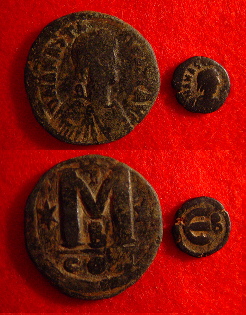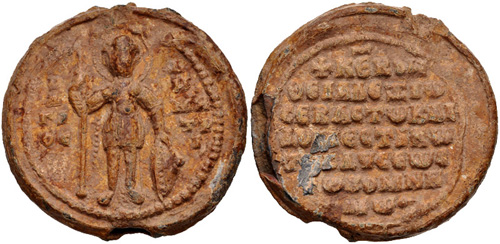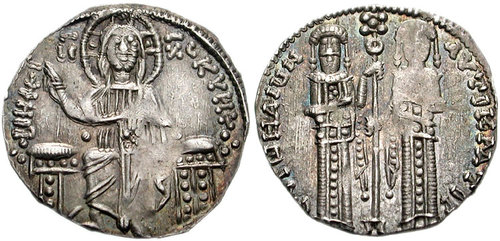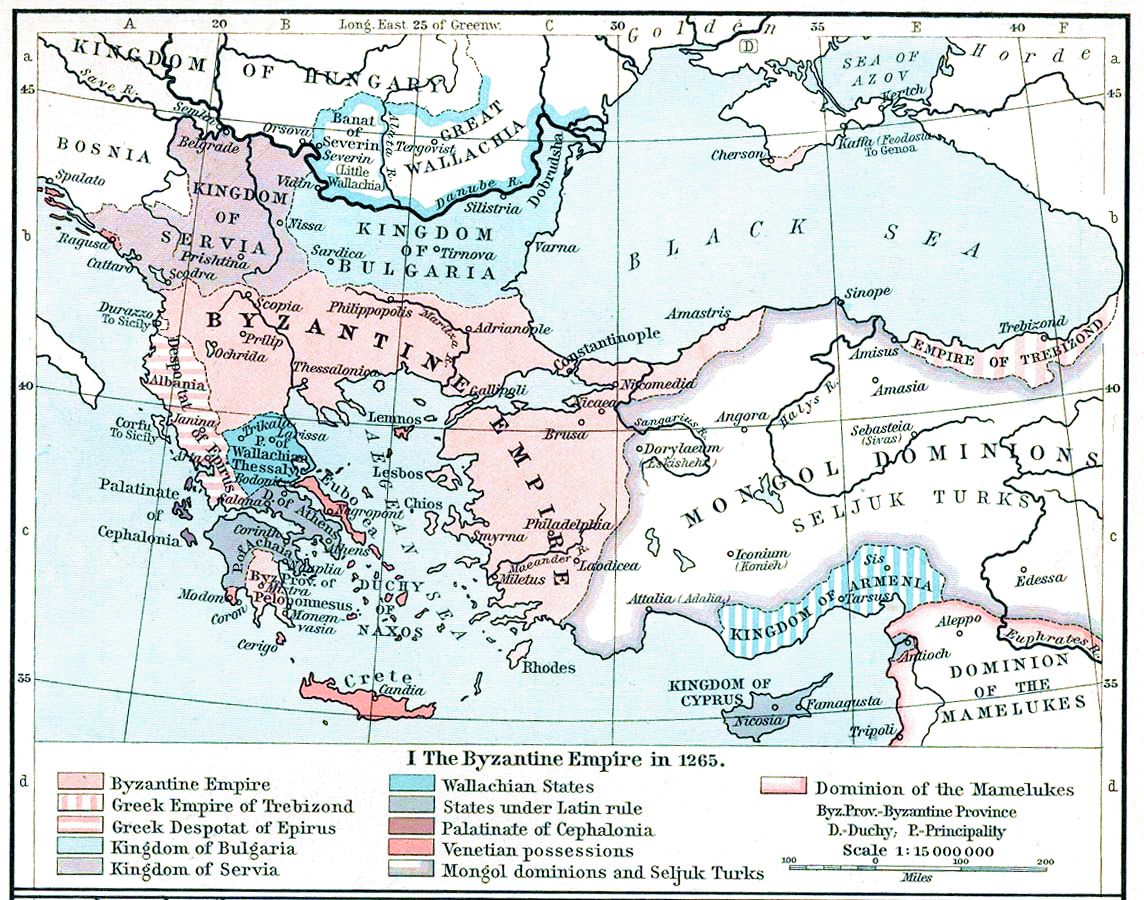|
Hyperpyron
The ''hyperpyron'' (, ''nómisma hypérpyron'' ) was a Byzantine coin in use during the late Middle Ages, replacing the '' solidus'' as the Byzantine Empire's standard gold coinage in the 11th century. It was introduced by emperor Alexios I Komnenos. History The traditional gold currency of the Byzantine Empire had been the '' solidus'' or '' nomisma'', whose gold content had remained steady at 24 carats for seven centuries and was consequently highly prized. From the 1030s, however, the coin was increasingly debased, until in the 1080s, following the military disasters and civil wars of the previous decade, its gold content was reduced to almost zero. Consequently, in 1092, Emperor Alexios I Komnenos ( 1081–1118) undertook a drastic overhaul of the Byzantine coinage system and introduced a new gold coin, the ''hyperpyron'' (meaning "super-refined"). This was of the same standard weight (4.45 grams) as the ''solidus'', but only 20.5 carat purity (0.854 fineness) instead of the ... [...More Info...] [...Related Items...] OR: [Wikipedia] [Google] [Baidu] |
Byzantine Coinage
Byzantine currency, money used in the Eastern Roman Empire after the fall of the West, consisted of mainly two types of coins: gold solidus (coin), solidi and Hyperpyron, hyperpyra and a variety of clearly valued bronze coins. By the 15th century, the currency was issued only in debased silver Stavraton, stavrata and minor copper coins with no gold issue. The Byzantine Empire established and operated several Mint (coin), mints throughout its history. Aside from the main metropolitan mint in the capital, Constantinople, a varying number of provincial mints were also established in other urban centres, especially during the 6th century. Most provincial mints except for Syracuse, Sicily, Syracuse were closed or lost to Arab–Byzantine wars, Arab Muslim invasions in the Mediterranean Region by the mid-7th century onwards. After the loss of Syracuse in 878, Constantinople became the sole mint for gold and silver coinage until the late 11th century, when major provincial mints began t ... [...More Info...] [...Related Items...] OR: [Wikipedia] [Google] [Baidu] |
Solidus (coin)
The ''solidus'' (Latin 'solid'; : ''solidi'') or ''nomisma'' () was a highly pure gold coin issued in the Later Roman Empire and Byzantine Empire. It was introduced in the early 4th century, replacing the aureus, and its weight of about 4.45 grams remained relatively constant for seven centuries. In the Byzantine Empire, the solidus or nomisma remained a highly pure gold coin until the 11th century, when several Byzantine emperors began to strike the coin with debasement, less and less gold. The nomisma was finally abolished by Alexios I Komnenos in 1092, who replaced it with the hyperpyron, which also came to be known as a "bezant". The Byzantine solidus also inspired the zolotnik in the Kievan Rus' and the originally slightly less pure gold dinar first issued by the Umayyad Caliphate beginning in 697. In Western Europe, the solidus was the main gold coin of commerce from late Roman times to the Early Middle Ages. In Late Antiquity and the Middle Ages, the solidus also ... [...More Info...] [...Related Items...] OR: [Wikipedia] [Google] [Baidu] |
Alexios I Komnenos
Alexios I Komnenos (, – 15 August 1118), Latinization of names, Latinized as Alexius I Comnenus, was Byzantine Emperor, Byzantine emperor from 1081 to 1118. After usurper, usurping the throne, he was faced with a collapsing empire and constant warfare throughout his reign, Alexios was able to curb the Byzantine decline and begin the military, financial, and territorial recovery known as the Komnenian restoration. His appeals to Western Europe for help against the Seljuk Empire, Seljuk Turks were the catalyst that sparked the First Crusade. Although he was not the first emperor of the Komnenos, Komnenian dynasty, it was during his reign that the Komnenos family came to full power and initiated a hereditary succession to the throne. The son of John Komnenos (Domestic of the Schools), John Komnenos and a nephew of Isaac I Komnenos, Alexios served with distinction under three Byzantine emperors. In 1081, he led a rebellion against Emperor Nikephoros III Botaneiates and took ... [...More Info...] [...Related Items...] OR: [Wikipedia] [Google] [Baidu] |
Bezant
In the Middle Ages, the term bezant (, from Latin ) was used in Western Europe to describe several gold coins of the east, all derived ultimately from the Roman . The word itself comes from the Greek Byzantion, the ancient name of Constantinople, the capital of the Byzantine Empire. The original "bezants" were the gold coins produced by the government of the Byzantine Empire, first the and from the 11th century the . Later, the term was used to cover the gold dinars produced by Islamic governments. In turn, the gold coins minted in the Kingdom of Jerusalem and County of Tripoli were termed "Saracen bezants" (), or "fake dinars" (), since they were modelled on the Fatimid dinar. A completely different electrum coin based on Byzantine was minted in the Kingdom of Cyprus and called the "white bezant". The term ''bezant'' in reference to coins is common in sources from the 10th through 13th centuries. Thereafter, it was mainly employed as a money of account and in literary ... [...More Info...] [...Related Items...] OR: [Wikipedia] [Google] [Baidu] |
Tetarteron
The ''tetarteron'' (, "quarter [coin]") was a Byzantine Empire, Byzantine term applied to two different coins, one gold circulating from the 960s to 1092 in parallel to the ''histamenon'', and one copper used from 1092 to the second half of the 13th century. Gold coin Ever since Emperor Constantine I (r. 306–337), the Byzantine Empire's main coinage had been the high-quality ''solidus (coin), solidus'' or ''nomisma'', which had remained standard in weight and gold content through the centuries. The Emperor Nikephoros II Phokas (r. 963–969), however, introduced a new coin which was a 2 carats (i.e. about 1⁄12, despite its name) lighter than the original ''nomisma'', which now became known as the ''histamenon''... The exact reason for the introduction of the ''tetarteron'' is unclear. According to the historian Joannes Zonaras, Zonaras, this was done to increase state revenues: the taxes were to be paid as before in the ''histamenon'', while the state paid its own expenses in ... [...More Info...] [...Related Items...] OR: [Wikipedia] [Google] [Baidu] |
Komnenian Period
The Byzantine Empire was ruled by emperors of the Komnenos dynasty for a period of 104 years, from 1081 to about 1185. The ''Komnenian'' (also spelled ''Comnenian'') period comprises the reigns of five emperors, Alexios I, John II, Manuel I, Alexios II and Andronikos I. It was a period of sustained, though ultimately incomplete, restoration of the military, territorial, economic and political position of the Byzantine Empire. Byzantium under the Komnenoi played a key role in the history of the Crusades in the Holy Land, while also exerting enormous cultural and political influence in Europe, the Near East, and the lands around the Mediterranean Sea. The Komnenian emperors, particularly John and Manuel, exerted great influence over the Crusader states of Outremer, whilst Alexios I played a key role in the course of the First Crusade, which he helped bring about. Moreover, it was during the Komnenian period that contact between Byzantium and the 'Latin' Christian West, includ ... [...More Info...] [...Related Items...] OR: [Wikipedia] [Google] [Baidu] |
Basilikon
The ''basilikon'' (, "imperial oin), commonly also referred to as the (Greek: δουκάτον), was a widely circulated Byzantine silver coin of the first half of the 14th century. Its introduction marked the return to a wide-scale use of silver coinage in the Byzantine Empire, and presaged the total abandonment of the gold coins around the middle of the century. History The ''basilikon'' was introduced shortly before 1304 by Emperor Andronikos II Palaiologos (r. 1282–1328), in direct imitation of the Venetian silver ducat or '' grosso'', chiefly to pay the mercenaries of the Catalan Company... The Byzantine coin closely followed the iconography of the Venetian model, with a seated Christ on the obverse and the two standing figures of Andronikos II and his son and co-emperor Michael IX Palaiologos (r. 1294–1320) replacing St. Mark and the Doge of Venice on the reverse. The similarity was reinforced by the name of the new coin: the ''ducato'', the "coin of the doge", becam ... [...More Info...] [...Related Items...] OR: [Wikipedia] [Google] [Baidu] |
Andronikos II Palaiologos
Andronikos II Palaiologos (; 25 March 1259 – 13 February 1332), Latinization of names, Latinized as Andronicus II Palaeologus, reigned as Byzantine emperor from 1282 to 1328. His reign marked the beginning of the recently restored empire's final decline. The Turks conquered most of Byzantium's remaining Anatolian territories, and Andronikos spent the last years of his reign fighting his Andronikos III Palaiologos, own grandson in the First Palaiologan Civil War. The war ended in Andronikos' forced abdication in 1328, after which he retired to a monastery for the remainder of his life. Life Early life Andronikos was born on 25 March 1259, at Nicaea. He was the eldest surviving son of Michael VIII Palaiologos and Theodora Palaiologina (Byzantine empress), Theodora Palaiologina, grandniece of John III Doukas Vatatzes. Andronikos was acclaimed co-emperor in 1261, after his father Michael VIII recovered Constantinople from the Latin Empire, but he was not crowned unti ... [...More Info...] [...Related Items...] OR: [Wikipedia] [Google] [Baidu] |
Byzantine Empire
The Byzantine Empire, also known as the Eastern Roman Empire, was the continuation of the Roman Empire centred on Constantinople during late antiquity and the Middle Ages. Having survived History of the Roman Empire, the events that caused the fall of the Western Roman Empire in the 5th centuryAD, it endured until the fall of Constantinople to the Ottoman Empire in 1453. The term 'Byzantine Empire' was coined only after its demise; its citizens used the term 'Roman Empire' and called themselves 'Romans'. During the early centuries of the Roman Empire, the western provinces were Romanization (cultural), Latinised, but the eastern parts kept their Hellenistic culture. Constantine the Great, Constantine I () legalised Christianity and moved the capital to Constantinople. Theodosius I, Theodosius I () made Christianity the state religion and Greek gradually replaced Latin for official use. The empire adopted a defensive strategy and, throughout its remaining history, expe ... [...More Info...] [...Related Items...] OR: [Wikipedia] [Google] [Baidu] |
Medieval Bulgarian Coinage
Medieval Bulgarian coinage were the coins minted by the Bulgarian Emperors during the Middle Ages at the time of the Second Bulgarian Empire. There is no evidence that coins were minted during the First Bulgarian Empire, and minting ceased after the fall of the Second Empire with Ottoman domination in 1396. They were gold (''perperi''), silver (''aspri''), billon (coinage of silver and copper) and copper coins, all flat and hollow. The inscriptions were usually in Bulgarian language and rarely in Greek. Due to the limited space the inscriptions were abbreviated, often written with a few letters and special signs. Artistically, they continued the Byzantine numismatic tradition but the designs were often more schematic. The main means of expression were lines and dots. The Bulgarian coins had images different from the Byzantine and Slav coinage, so they form a distinct group. The coins are an important source for the history of the Second Bulgarian Empire. Ivan Asen II Tsar ... [...More Info...] [...Related Items...] OR: [Wikipedia] [Google] [Baidu] |
Assarion
The ' (: '), occasionally ''assarius'' (: ''assarii''; ), was a bronze, and later copper, coin used during the Roman Republic and Roman Empire. Republican era coinage The Romans replaced the usage of Greek coins, first by bronze ingots, then by disks known as the ''aes rude''. The system thus named ''as'' was introduced in ca. 280 BC as a large cast bronze coin during the Roman Republic. The following fractions of the were also produced: the (), (), (), (), (), (), (, also a common weight unit), and (), as well as multiples of the ''as'', the (2), (2), and (3). After the ''as'' had been issued as a cast coin for about seventy years, and its weight had been reduced in several stages, a ''as'' was introduced (meaning that it weighed one-sixth of a pound). At about the same time a silver coin, the ''denarius'', was also introduced. Earlier Roman silver coins had been struck on the Greek weight standards that facilitated their use in southern Italy and across th ... [...More Info...] [...Related Items...] OR: [Wikipedia] [Google] [Baidu] |
Michael VIII Palaiologos
Michael VIII Palaiologos or Palaeologus (; 1224 – 11 December 1282) reigned as Byzantine emperor from 1261 until his death in 1282, and previously as the co-emperor of the Empire of Nicaea from 1259 to 1261. Michael VIII was the founder of the Palaiologos, Palaiologan dynasty that would rule the Byzantine Empire until the Fall of Constantinople in 1453. He Reconquest of Constantinople, recovered Constantinople from the Latin Empire in 1261 and transformed the Empire of Nicaea into a Byzantine Empire under the Palaiologos dynasty, restored Byzantine Empire. His reign saw considerable recovery of Byzantine power, including the enlargement of the Byzantine army and Byzantine navy, navy. It also included the reconstruction of the city of Constantinople, and the increase of its population. His re-establishment of the University of Constantinople contributed to the Palaeologan Renaissance, a cultural flowering between the 13th and 15th centuries. It was also at this time that the fo ... [...More Info...] [...Related Items...] OR: [Wikipedia] [Google] [Baidu] |










